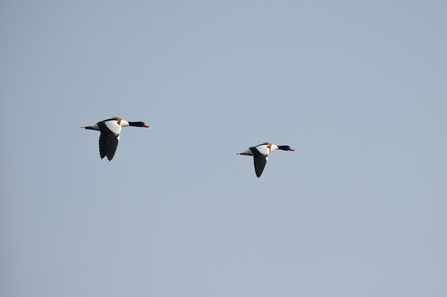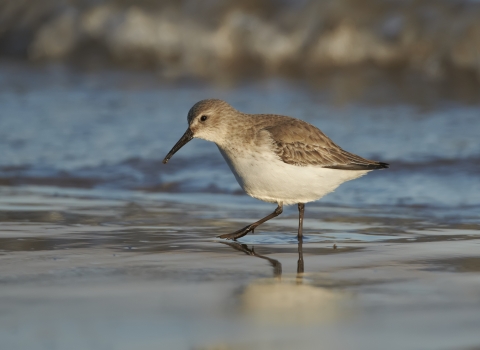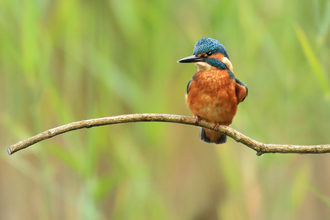The Mersey Estuary and the Mersey Narrows and Wirral Foreshore are both designated as Special Protection Areas (SPAs)
How important is the Mersey Estuary for nature’s recovery?
The Mersey Estuary is a complex habitat of tidal mudflats, saltmarshes and rocky shores, which is home to rare species of plants and animals and supports tens of thousands of birds. With marine life and seabirds under threat from all angles, protecting these habitats is of crucial importance.
The Mersey Estuary, and the Mersey Narrows & Wirral Foreshore, are designated as internationally important Special Protection Areas (SPAs) for their shorebird assemblages. The estuary is also protected under the 1971 United Nations’ Ramsar Convention on Wetlands, signed by 169 countries, of which the UK was one of the first.
The estuary is internationally important (supports at least 1% of the European population) for 6 bird species:
-
Common Shelduck (4.2%)
-
Black-tailed Godwit (5.7%
-
Common Redshank (2.6%)
-
Eurasian Teal (2.6%)
-
Northern Pintail (2%)
-
Dunlin (3.6%)
It is nationally important (supports at least 1% of the United Kingdom’s population) for 5 additional bird species:
-
Ringed Plover (1.3%)
-
Eurasian Curlew (1.3%)
-
Spotted Redshank (2.2%)
-
Common Greenshank (1%)
-
Eurasian Wigeon (2%)
It also supports populations of key migratory fish species – notably Atlantic Salmon, identified as a Priority Species under the UK’s Post-2010 Biodiversity Framework.
What is a tidal barrage?
After decades of improvements to the water quality of this internationally important wildlife refuge, it now faces a new, perhaps even greater challenge.
A tidal barrage involves a dam-like structure that can be built across the mouth of an estuary.
During low tide, the gates of the barrage are open, allowing water to pass through. At high tide, the gates are shut, creating a temporary lagoon. Once the tide has subsided on the seabound side, the gates open again and the force of the water passing through the turbines generates electricity.
Controlling and changing the tide has significant environmental impacts because it disrupts the natural tidal cycle in the surrounding land. The mudflats and saltmarshes that characterise the estuary depend on the tides.
At high tide, they are submerged and at low tide they are exposed to create a feeding zone rich in life. Any interference with the tides (i.e. changes in water level, sediment loads, and salinity) risks the disruption of the delicate balance that creates these sensitive habitats, which cannot be replaced.
The Timeline
Harnessing tidal power across the Mersey Estuary is not a new idea – it was first put forward in 1924 - but the Liverpool City Region Combined Authority is now working up a proposal for a tidal barrage across its shores. While it would provide a source of renewable energy to help power the area as an alternative to fossil fuels, the scheme risks lasting damage to, and possible destruction of this nationally and internationally important wildlife site.
In 2011, multi-billion-pound private sector plans to harness the estuary’s tidal flow were put on hold, safeguarding – for now – populations of wading birds, ducks and fish that may have been severely impacted by proposals to build a tidal barrage.
However, in 2018, Liverpool City Region’s Metro Mayor’s Office commissioned an economic feasibility study for tidal energy production from the Mersey Estuary. This indicated that, although the economics were now more favourable, these still fell short by 20%.
On 28 February 2020, the Liverpool City Region Combined Authority approved £2,500,000 to carry out the next phase of work and so develop a preferred option to take forward to planning.
In 2022 proposals were put forward for three alternative tidal energy systems, a barrage across the estuary, a tidal lagoon attached to the Wirral North Foreshore, and a tidal lagoon offshore in the Irish Sea’s Liverpool Bay.
Scoping assessments were commissioned on economic and environmental impacts of each option. Relevant surveys and analyses were undertaken from 2020-2022.
In 2023, it was decided that the barrage was the best option; mainly on economic grounds, we understand.
In 2024, researchers from Liverpool John Moores University found that the Mersey basin was one of world’s most contaminated by “Forever Chemicals” (Per- & Poly-fluorinated Alkyl Substances – PPFS for short) adding to existing concerns about the impacts of construction and operation on releasing the toxic legacy of industrial chemicals currently trapped in the seabed sediments.
If the LCRCA decides that it is worth proceeding, a Development Consent Order for national infrastructure would be sought from the UK Planning Inspectorate. If approved, the aspiration is for construction to start in 2027 and operation from 2032.

Shelduck by Terry Whittaker/2020VISION
What are we doing?
We’ll be working with Cheshire Wildlife Trust on our detailed response to this latest proposal, and also liaising with the North Wales Wildlife Trust, as these proposals may have knock-on effects on coastal and intertidal habitats in Flintshire and Denbighshire. We’re also participating in the Mersey Tidal Power Project’s Environmental Stakeholders’ Workshop, convened by the Liverpool City Region Combined Authority.
Back in 2011, alongside Cheshire Wildlife Trust, we published our views on the then barrage proposals, which did not progress, in a document entitled ‘Mersey Matters’. This document will be updated in response to the new proposals from the devolved Liverpool City Region Combined Authority as these progress to an application to the Planning Inspectorate for consent for national infrastructure development.
Read The Wildlife Trusts’ 2011 view in the Mersey Matters report at the bottom of this page - most of it remains valid.
Sustainable development
The Wildlife Trust for Lancashire, Manchester & North Merseyside is supportive of renewable energy projects if they are sustainable.
Sustainability is not just about ‘net zero’, it is also about considering the full impact of a project on the natural environment, including the wildlife.
Potentially irreversible changes caused by the construction of a poorly designed barrage, such as the design that was put on hold in 2011, could put at risk this incredibly important ecosystem and the survival of the species that rely on it.
The leaders of the United Nations agreed what sustainable development looks like and created the 2030 Sustainable Development Goals. If a development breaches a goal, then it is not considered sustainable. While a barrage across the Mersey might meet the clean energy, climate, and infrastructure goals, it would almost certainly breach the two biodiversity goals relating to life on land and in water.
- Breached: Goal 14 Life Below Water - conserve and sustainably use the oceans, seas and marine resources for sustainable development.
- Breached: Goal 15 Life on Land - protect, restore and promote sustainable use of land ecosystems, and halt and reverse land degradation and halt biodiversity loss.
- Met: Goal 7 - affordable clean energy: - ensure access to affordable, reliable, sustainable and modern energy for all.
- Met: Goal 9 - Industry, infrastructure and innovation: - Build resilient infrastructure, promote inclusive and sustainable industrialization and foster innovation
- Met: Goal 13 climate action - take urgent action to combat climate change and its impacts
The UK Government committed to these goals in its 25-year environment plan.
Common Eel by Julie Hatcher



